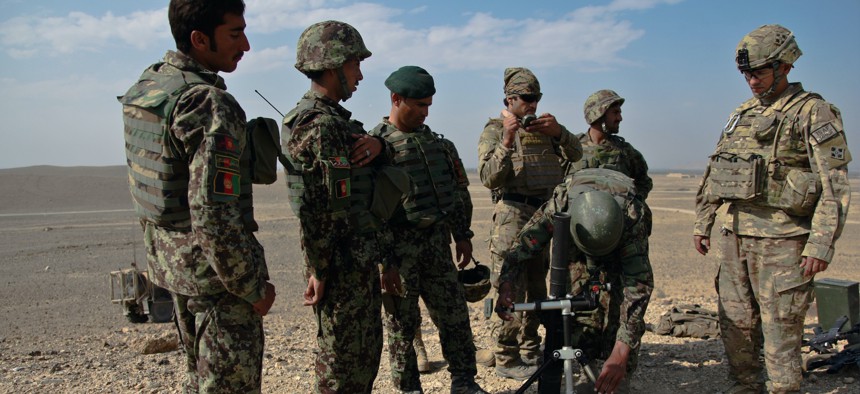
U.S. Army Staff Sgt. Lazarus Gonzalez with the 4th Infantry Division observes an Afghan National Army soldier as he adjusts his aim during field artillery training at Shinwar, Nangarhar province, Afghanistan, in 2012. U.S. Army / Spc. Ryan Hallgarth
The U.S. Spent $83 Billion Training Afghan Forces. Why Did They Collapse So Quickly?
The U.S. is rushing enough airpower to evacuate thousands as the Taliban advances on Kabul.
Updated: Aug. 14, 3:42 p.m.
U.S. Air Force cargo planes and contracted aircraft are headed to Afghanistan to evacuate potentially thousands of Americans and Afghans per day as the Taliban advances on Kabul, Pentagon spokesman John Kirby said Friday.
On Thursday the Taliban took Afghanistan’s second largest city, Kandahar, and advances by Taliban fighters have put the country’s capital at risk of falling.
“Time is a precious commodity here,” Kirby said. “Clearly from their actions it appears as if they are trying to get Kabul isolated.”
The need for the rapid departure has raised concern within the Pentagon: How could the U.S.-trained Afghan military collapse so quickly?
The United States has spent almost $83 billion equipping and training the Afghanistan National Defense and Security Forces, or ANDSF, since 2002, including providing almost $10 billion in aircraft and vehicles, according to the U.S. Special Inspector General for Afghanistan Reconstruction.
“We have noted with great concern the speed with which they [the Taliban] have been moving and the lack of resistance they have faced” from U.S.-trained Afghan military units, and it was time for those units to fight back, Kirby said.
“They have an air force, which, oh, by the way, is flying more air strikes than we are everyday. They have modern equipment. They have organizational structure,” Kirby said. “They have the benefit of training that we have provided them over 20 years. They have the material, the physical, the tangible advantages. It’s time now to use those advantages.”
Some security experts say the United States should have seen this collapse coming. U.S. forces trained the Afghan army after its own image, with a centralized, national hierarchy and western style of fighting, even when it became clear that large U.S. Army operations in Afghanistan would have to adjust and adapt to insurgent attacks and asymmetric warfare.
“We thought things like Humvees and tanks and artillery pieces and helicopters made it strong,” said Bill Roggio, senior fellow at the Foundation for Defense of Democracies, who has opposed Biden’s Afghanistan plan.
All that gear and national focus, instead of strengthening highly-localized units defending their own homes, did not inspire a will to fight, he said.
Systemic corruption and a weak Afghan government that failed to ensure Afghan forces were paid, or received proper care and compensation after getting wounded, made it worse.
“Are you going to expect people from the North to go fight and die in Helmand? Or Kandahar?” Roggio said.
Afghanistan’s commando forces were an exception to this, Roggio said.
Marine Corps veteran Dan Grazier, a fellow at the Project on Government Oversight, said when U.S. training of Afghan forces first began, there was no overall plan on how to build a successful Afghan Army that could sustain itself. That left the shaping to individual U.S. military units that frequently rotated out, losing progress or continuity of training.
“Because we didn't have resident experts at the beginning, the Army and Marine Corps essentially defaulted to what they knew and tried to craft the Afghan Army in their own image,” Grazier said. “We trained them to capabilities and provided them with a bunch of equipment they couldn't sustain on their own.”
Biden officials earlier this year had promised to continue equipping Afghan forces with cash and weapons as U.S. troops withdrew, but the Taliban’s advance—and the number of Afghan units flipping sides—has observers like Roggio asking whether U.S. logistical and equipment support should continue?
“It’s hard to recommend you pour any more war material into Afghanistan if Afghans are not going to use it to fight,” Roggio said.
In July, the Special Inspector General for Afghanistan Reconstruction found the Defense Department has spent $3.74 billion on fuel for Afghan forces from fiscal year 2010 to 2020 and “plans to spend an additional $1.45 billion through FY 2025.”
“This fuel was required to operate more than $9.82 billion in vehicles and aircraft DOD procured for the ANDSF, and to provide power to ANDSF bases and installations.”
Over the last 20 years the U.S. has given the Afghan Air Force more than 130 aircraft. In July, the Defense Department said it was providing the Afghan Air Force more aircraft—including 35 Black Hawks and three A-29 Super Tucanos—in a sign of continued commitment to the Kabul government even as U.S. forces withdrew. Three of the Black Hawks were delivered last month.
The Defense Department was not able to immediately respond to a request for comment on whether or not those additional aircraft would still be sent, or be held back, to keep them from falling into Taliban hands.
The Pentagon was also working on plans to provide future contracted maintenance support for the Afghan Air Force that would have been conducted remotely. On Friday, Kirby said that DOD is still planning to provide Afghan forces that resupply and maintenance support.
“We are focused on the security situation as we see it now,” Kirby said.
Congress has already put one block in place, with a stipulation in the fiscal year 2022 National Defense Authorization Act that would cut off that aid if Kabul falls. The bill directs that “none of the funds provided may be ‘available for the transfer of funds, supplies, or other items of monetary value to the Taliban or members of other terrorist groups.’”
The rapid collapse of the Afghan army across Afghanistan also increased concerns that the thousands of interpreters and others who aided Americans and are waiting for visas to exit Afghanistan could be left behind.
The United States is speeding additional aircraft and personnel to Kabul’s airport to keep the runways open to allow U.S. airlift to get people out safely.
Kim Motley, an attorney who has worked in Afghanistan since 2008, has been assisting Afghans with the special immigrant visa process. She said she’s been hearing from worried Afghans who do not understand why their visas have not been processed.
“I do think the sentiment is that the U.S. is abandoning them,” Motley said. “This is a human rights nuclear bomb and the international community lit the match.”







